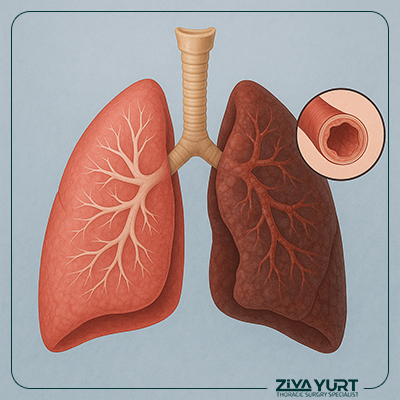Modern Treatment Approaches
In recent years, innovative therapies have emerged that directly target the components of COPD. Among the most notable are:
Treatment of Airway Narrowing Using Abrasive Balloon Technique
Main Techniques for Treating Pulmonary Emphysema
Endobronchial Coils
Flexible metallic springs are inserted via bronchoscopy into hyperinflated lung areas. These coils compress the excess tissue, reduce the volume of the damaged regions, and redistribute air to healthier areas.
Endobronchial Valves
One-way valves are implanted in the bronchi leading to the affected lobes. These valves allow trapped air to exit while preventing further air entry. This causes the diseased area to collapse and allows better ventilation of the remaining lung.
Key Benefits of Endoscopic Interventions for Airway Narrowing and Emphysema
- Significant improvement in lung ventilation efficiency and reduced sensation of chronic breathlessness
- Relief of air trapping pressure in the affected lobes, leading to improved diaphragm function and respiratory balance
- Enhanced walking ability and daily physical activity
- Reduction or cessation of home oxygen therapy and long-term supportive treatments for some patients
- Improved effectiveness and response to inhaled medications after restoring proper ventilation
- Prevention of expected decline in lung function in patients with COPD or emphysema
- Enhanced quality of life, including better sleep, physical endurance, and independence in daily tasks
- Delaying or avoiding lung transplantation in advanced cases by stabilizing respiratory function
- Increased oxygen saturation and reduced carbon dioxide retention, especially after improving ventilation in viable lung areas
- Achieving respiratory stability in carefully selected patients based on comprehensive evaluation
📚 Global Scientific References
The use of balloon, valve, and coil techniques in treating obstructive lung diseases is based on reliable clinical studies and scientific reviews, including:
-
LIBERATE Study on Zephyr Valves (ATS Journals, 2018): Demonstrated significant improvements in lung function and quality of life in emphysema patients
-
RENEW, RESET, and REVOLENS Trials on endobronchial coils (Respiration Journal, 2017): Confirmed their efficacy in improving breathing and reducing symptoms
-
Studies published in CHEST and Journal of Bronchology supported the use of balloon techniques to safely and effectively dilate benign airway stenosis
📎 These findings are incorporated into standardized treatment protocols endorsed by the American Thoracic Society (ATS) and European Respiratory Society (ERS) and are applied in advanced medical centers around the world.

